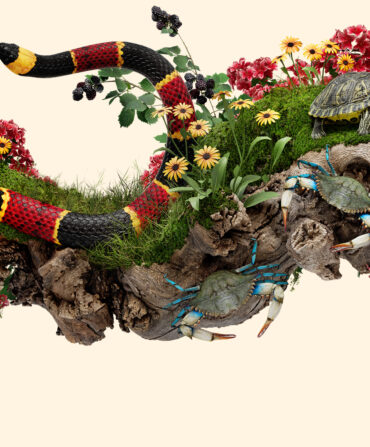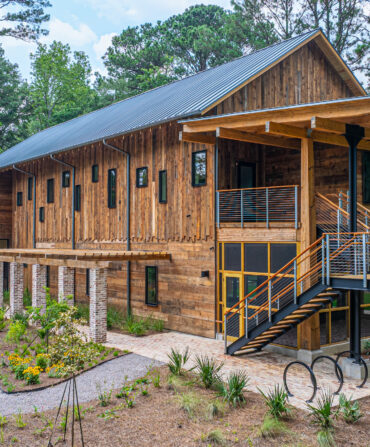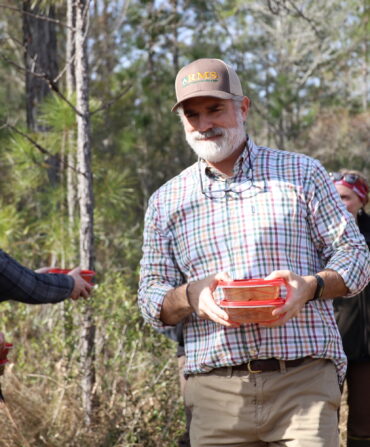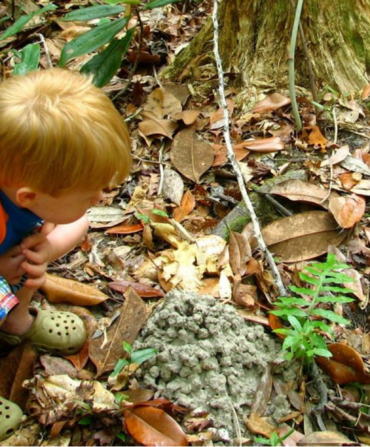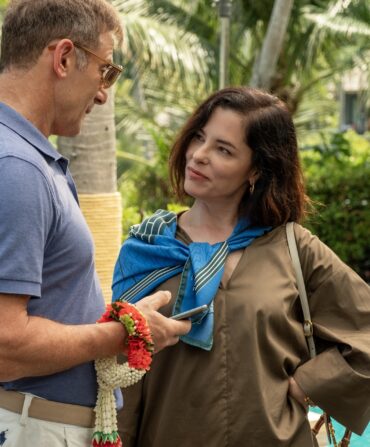I’m lying on my stomach in a ditch on the side of the road in Boiling Spring Lakes, North Carolina, watching a horror story play out in miniature. On the surface the scene looks innocent enough—a beautiful white blossom crowning a long, pale-green stalk. Follow the stem down, though, and things get strange. In place of normal leaves, what look like tiny pink and green mouths sit agape. Some are flush to the ground, others rise on oddly geometric stalks, and each is rimmed by a creamy set of what might be sweeping eyelashes or very long, white teeth.
This is a plant equipped to kill, and about to kill in real time, because a carpenter ant has just wandered into the danger zone. I watch with a mixture of dread and fascination as the insect hurries along the eyelashes that will become jail bars should it trip the three fine trigger hairs sitting in an innocuous-looking triangle on each side of the trap. In its frenetic scuttle, it bumps one hair with its segmented body, and the clock starts ticking. The ant has twenty seconds. If it hits a second trigger hair within that time, the trap will—
Snap.
It happens so fast I cannot believe it happened at all. But through the thin green membrane of the leaf, I can see the shadow of the ant fighting to escape in a struggle that literally seals its fate. It’s hitting the trigger hairs again and again, and in response, the trap closes tighter and begins to excrete the digestive enzymes that will slowly turn this creature into a meal over a week or more.
“Pretty neat, right?” comes a voice from somewhere above me. Heart pounding, I look up and see Julie Moore, the flytrap queen herself, her blue eyes glittering as she leans on a cane and watches me watching the plant she has dedicated her life to saving. “Come on, we’ve got more to see.” Still shaken by the fate of the ant, I stand, dust myself off, and climb into Moore’s red convertible, and we’re off onto the flat, grid-like roads of Boiling Spring Lakes.
Over the next few days, I’ll learn the story of the weirdest plant that ever stumbled its way into being over the long march of evolution. I’ll also check into a groovy roadside motel, spend time with a seventy-eight-year-old stick of dynamite masquerading as a harmless little old lady, and explore a North Carolina town built on a landscape of fire and flood as it rallies behind something rare, precious, and improbably predaceous: the one and only Venus flytrap.
How did we end up with a plant with an appetite in the first place? Ask Julie Moore that question—where Venus flytraps come from—and she’ll tell you aliens put them here. The truth is, after all, kind of a long story.
So many millions of years ago that it boggles the mind, a flytrap started out as a well-behaved plant that absorbed sunlight and carbon dioxide and transformed it into biomass. But somewhere along the way, its difficult habitat made demands sunlight alone couldn’t meet. The sandy soil of the Carolina Coastal Plain lacks nitrogen and phosphorus, two key ingredients for life. Pair a string of lucky mutations with the magic of natural selection over deep time, and this ancient plant—along with a host of others—ended up with the ability to secrete digestive enzymes that would break down animals rich in those very ingredients.
To catch them, Venus flytraps developed modified leaves that serve as traps, which excrete a sweet nectar to entice insects to investigate. They grow into a convex shape until an electrical current snaps them into their concave and murderous form, like a bottle cap popped in and out. “In the process of growing, the trap stores the elastic energy like a stretched rubber band,” explains Clyde Sorenson, an entomologist at North Carolina State University. “Then, when the chemistry changes, that energy is released and it snaps closed into its resting state.”
Really, Sorenson points out, the plant should be called the Carolina spidertrap, because it’s got nothing to do with Venus and hardly, if ever, catches flies. The most common victims are wolf and lynx spiders, carpenter ants, and daddy long-legs. “Of course, all sorts of things blunder into the traps while making their merry way across the savanna floor,” Sorenson says—that is, except the pollinators. Sorenson has spent years piecing together this ecological puzzle and discovered that flytraps do not eat those that play a role in their propagation. Instead, the long stalk below their head of flowers allows visitors like green sweat bees, checkered beetles, and notch-tipped flower longhorn beetles to drop by, have a sip of the sugar in the blooms, and fly on to the next flytrap, disseminating DNA, keeping flytrap populations genetically healthy, and avoiding slow death in return for the favor.
For reasons biologists still don’t fully understand, flytraps’ native range is limited to a roughly eighty-mile strip of the eastern Carolinas, concentrated in North Carolina. Early settlers were fascinated by them. Charles Darwin, who never traveled to North America but corresponded extensively with botanists there, declared them “one of the most wonderful plants in the world.” Today they are known and grown the world over, turning up in botanical gardens, in the home collections of carnivorous plant enthusiasts, and in pop culture. (Audrey II in Little Shop of Horrors and the piranha plant in Super Mario Bros. are two memorable homages.) “But most people think they are from the rainforest or from Borneo, somewhere exotic,” Moore says.
Like many highly specialized species, they are fighting extinction as development steadily encroaches. They once grew in stunning abundance across their small range. Today, less than one hundred distinct populations remain in North Carolina, half of them harboring fewer than five hundred plants and some with less than a dozen.
Still, some hotspots exist, and the rapidly growing town of Boiling Spring Lakes is one of them.
When I first drove into town, l noticed something curious stamped in white on the welcome marker: icons that denote no mowing and no pesticides. I continued down Highway 87, turned off at a bright purple, red, and yellow sign for the Boiling Spring Lakes Motel, and checked into my unlocked, spotless room overlooking blooming magnolia trees and a sloping wetland. Soon after, an unmissable red Mercedes-Benz Kompressor wheeled up to the parking lot. Julie Moore had arrived.
At first glance Moore looks sweet. She hails from coastal Virginia, stands about five-foot-five, and currently walks with a cane thanks to a recent hip and knee replacement; to that cane she’s tied a piece of bright pink flagging tape lest she drop it in some wild place. She has curling white hair, bright blue eyes, and an open smile. You would perhaps assume she spends her time knitting or doting on grandchildren, and you would be wrong.
Here is a woman who has dedicated her razor-sharp mind, boundless energy, and capacity to take charge to the conservation of Southern ecosystems. Her love for plants, which took root in high school, led her to study botany at Tulane University and then to positions with the North Carolina Natural Heritage Program and as an endangered species specialist for the U.S. Fish & Wildlife Service. She’s led conservation efforts for an obscure snail (the magnificent ramshorn), a hyperspecialized amphibian (the Wyoming toad), and a curio cabinet of other odd and rare specimens, learning along the way what it takes to save a species on the brink. In her retirement she selected the recovery of the Venus flytrap—what she calls “an easy sell”—as her mission.
Julie Moore.
Over pizza and beer, she tells me that, just between us, the town of Boiling Spring Lakes should really never have been built at all, because it’s slapped down right in the middle of an inhospitable landscape. Historically this open, sun-soaked ecosystem was dominated by longleaf pine—a tree that is built to burn. Cleansing fire, started by lightning strikes or Native American activity, once crackled in a mosaic across the savanna, and the thick bark of longleaf pine weathered the flames. Ever adaptable, longleaf could stand the water, too, and in these low-lying lands, frequent floods create pockets of wetlands.
A place where fire and water converge isn’t ideal for settlement, so it wasn’t until the 1960s that a push to build a town gained momentum. The Reeves Broadcasting Corporation purchased the land and launched an advertising campaign to sell off lots; flyers trumpeted that Boiling Spring Lakes, located conveniently close to Wilmington and the coast, promised fast-growing home value. It worked. People came, and the town suppressed its fire. They dug ditches to control the flooding. Concrete went down and houses went up, all in the beating heart of Venus flytrap habitat. Untold thousands of plants were paved over, mowed down, pulled up, and choked out, and no one thought too much of it—until Moore came to town in 2021.
“They’ve got flytraps in their backyards here,” she says. “Hell, they’ve got flytraps in their front yards. This town is flytrap central.” She arrived on the heels of a dose of bad news: Despite evidence that the plant was in serious trouble, the federal government had declined to list it as endangered. But the campaign to gain that designation did achieve one thing: maps outlining the exact locations of healthy, wild flytrap populations. “The fact that it wasn’t listed didn’t stop me a bit,” Moore says. She set out to knock on the doors of private landowners in and around the town and drum up support. But first, she booked herself at the Boiling Spring Lakes Motel.

Photo: Wes Overvold
The tiny six-room Boiling Spring Lakes Motel opened in the ’60s as a place for prospective buyers to stay while they evaluated properties in the new town. Over time, as roadside motels do, it became a little run-down. One owner disappeared. The next decided to sell, and by then Stephanie Hanson had moved back to her home state and set her eye on a second career after decades in nursing. She bought the motel in 2018 and spent two years renovating it into the last kind of thing—or maybe exactly the kind of thing—you’d expect when driving down Highway 87 to the coast. There’s a jukebox in the reception area, a poster of Aerosmith in one room, a big stone dinosaur painted lime green on the back lawn. In 2020 the newly embellished motel started welcoming guests, one of whom would be Moore.
“Julie is a force of nature,” Hanson tells me as we stand in the lobby, where a Venus flytrap sculpture perches on a shelf. Soon after meeting, she recalls, the pair sat on the back porch and got to chatting about Moore’s mission. “I realized after listening to Julie talk that we need to recognize the treasure we have and protect them.”
So Hanson went to the board of commissioners and petitioned them to designate the flytrap as the town plant. She succeeded. People’s ears perked up at the mention of the plant, and as word spread, so did pride. A former mayor phoned Hanson when she suspected someone was poaching them; Hanson got the U.S. Fish & Wildlife Service involved. A friend called her when she saw a Department of Transportation worker mowing down blooming flytraps on the side of the roads in the springtime. Another meeting with the board of commissioners later, the town elected to take over all of its own mowing.
Most importantly, for the past two years now, the town manager has alerted Hanson whenever further development is planned so that the BSL Plant Rescue—as the organization of interested parties is now named—can leap into action. Hanson sends out the word, and volunteers arrive with shovels, transport cups, and bottles of water. Together they dig up flytraps and ferry them to safety. Sometimes as many as twenty-five people turn up. “It’s so much fun,” Hanson says. “My friend Amber wears a hat with a Venus flytrap on it. We laugh and joke, and people call and want to be part of this grassroots gathering.”
Already the group has saved thousands of flytraps. “Never in my wildest dreams did I think I would become involved in conservation like this,” Hanson says, shaking her head. “But it’s such a worthy cause, because these plants are just incredible.”
Easy as it is to spot a flytrap in town, there’s a place nearby where the plant is truly in its element, and so Moore and I drive an hour inland from Boiling Spring Lakes to the Green Swamp. On the way I learn an assortment of delightful facts: Moore has been married twice and divorced twice and refers to those former partners as her favorite and least favorite ex-husbands. (The least favorite called her the Nightmare on Elm Street when they lived on Elm Street.) Her medical chart includes a note that she bites when coming out of anesthesia because her doctor learned that the hard way. She’s a certified burn boss (yes, that’s an official title) and loves nothing more than mobilizing people to wield cleansing, controlled fire. She’s aware that she looks innocent and demure and says it helps her “get away with a lot.” She’s a big-picture thinker, a connector of people and ideas, and the Green Swamp, as an outstanding example of an intact longleaf pine ecosystem, has a special place in her heart.
The over-16,000-acre Nature Conservancy preserve is a haven for all manner of wildlife, and in May it’s hot and humid and the sun soaks through gaps in the trees, lighting on the feathery heads of sprouting longleafs. “When I was young, I wanted to see old trees,” Moore says as we walk along a sandy path littered with pine needles. “Now that I’m old, I love to see young trees.”
The longleaf pine savanna of the Green Swamp Preserve.
When we come across our first flytrap, I crouch to inspect it and see that there are many more flytraps—almost a carpet of flytraps—on the forest floor, some obvious, others so small and close to the ground the eye roves over them. But down at ground level, it’s a gruesome scene. Most of the traps are open and inviting. Others reveal varying stages of digestion—in one, a winged ant is caught halfway in and out of the trap, its legs twitching desperately in a battle already lost because the eyelashes of the trap are interlaced so seamlessly. In another trap I see a long-legged spider and wonder why the plant isn’t snapping shut. Then I look closer and realize the insect is already dead; just the indigestible sheath of chitin remains, stuck to the trap by the vestiges of fluids that leaked from its dying body.
I can’t tear my eyes from the carnage, or from the spider about to hit its second trigger hair and die a horrible death. But as Sorenson, who has watched untold numbers of insects perish in the grips of a flytrap, points out, “Most animals don’t shuffle off their mortal coil in a pleasant way. Flytraps aren’t evil. They are just living in a tough environment, and this is a really elegant solution to a problem.”
Observing that elegance in action, I pepper Moore with questions about how exactly the mechanism works and how it evolved. Finally she loses patience. “Flytraps are just the bait,” she declares. “What fascinates me is how this whole forest system works together.”
In the complex ecological dish that is the Green Swamp, flytraps are just one ingredient. The understory is positively bristling with diversity: Carolina asphodel, wire grass, bluestem, and wild orchids all grow alongside a bright orange flower that Moore calls the Cheeto plant for evident reasons. And the flytrap is not the only local vegetation that struck on the ability to snack as a means of survival; this preserve alone is home to fourteen species of carnivorous plants. Settled near a flytrap flush against the ground, another silent killer awaits—the sundew. Glistening red hairs sport glands that produce sticky, dew-like secretions that capture prey like glue; then, its leaves can curl around the unlucky intruder and let digestive enzymes go to work. There’s the stately yellow pitcher plant, a foot-tall killer whose waxy rim causes insects to slip to a watery, acidic end.
With longleaf as the defining element of structure and fire as the agent of renewal, all of these plants add up to an ecosystem—and a home for red-cockaded woodpeckers, Bachman’s sparrows, salamanders, tortoises, and all sorts of insects, which, despite the peril that lurks on the forest floor, have thrived here for millions of years. “When you save flytrap habitat, you save all of it,” Moore says, gesturing around her. “You save all of this.”
Back in town, I see what the plant is up against. Boiling Spring Lakes is still growing fast—several thousand residential lots are earmarked for sale. Within the next few months, bulldozers will rake away more plant life to make room for concrete foundations. But I also see the human chain, linked by contagious enthusiasm, that could save it. In a little shopping center outfitted with a coffee shop, gym, and real estate office, Moore takes me to a square lot that’s as yet undeveloped and swimming in flytraps. As we poke around, a curious real estate agent meanders over, and Moore is in her element, flytrap-like herself in the way she brings people on board with her cause. In no time, the agent is helping Moore over the curb and guiding her back to his office to talk flytraps, agreeing that they are an amenity to the town. And he’ll call, he says, if he hears of impending development in the empty lot.
Later, at another soon-to-be-developed site, Moore has a plan for me, and Hanson has lent me a shovel. Though the BSL Plant Rescue has removed most of the flytraps from this tract, a few remain because when habitat is right, they present in incredible abundance. “Pick one,” Moore says. “We’re going to do your own private rescue.”
I drive the shovel into the dirt and carve out a circle as Moore tells me to, then work my way under the flytrap. Its roots aren’t deep, and within a minute I am scooping plant, flower, dirt, roots, and all into a cup for transport. We drive five minutes to the Boiling Spring Lakes Community Center, where Moore, of course, is cooking up another one of her visions.
In partnership with the North Carolina Plant Conservation Program and Venus Flytrap Champions, Boiling Spring Lakes has set aside a receiving ground for flytraps displaced by development. The BSL Plant Rescue volunteers brought the first batch to this five-acre patch of land. No one was sure the plants would thrive.
I follow Moore down the path, carrying my precious cargo and shovel. “I am really proud of this place,” she says, looking around at the hundreds of flytraps that grow in the sandy soil that backs up to a small pond. “I want the people of Boiling Spring Lakes to be able to come here and see how biologically unique their hometown is.” She envisions a walking trail with a boardwalk and educational signage, using the Stanley Rehder Carnivorous Plant Garden at Piney Ridge Nature Preserve in Wilmington as a model. Naturally, she’s already got the Lower Cape Fear chapter of the North Carolina Wildlife Federation lined up to take on the project.
I select a patch of earth and sit down to dig. My flytrap’s shallow root system doesn’t require a very big hole, and soon I’m lowering it into its new home. Moore tells me to pack the plant in tight to remove any air pockets, so I burrow my hands into the soil, feeling its grit under my fingernails, until the flytrap is integrated seamlessly in the ground. Then I shake water over the plant, a parting gift to get it off to the right start.
“There is no substitute for doing it yourself,” Moore remarks as we stand back and survey my work. Looking at all the other plants, individually dug up and replanted by different hands, I see the collective effect of pride, empowerment, and ownership.
Back at the motel, I start to tell Hanson about the experience—about how I felt moving this little horror story of a plant, so lethal and so vulnerable at the same time, to a safe haven. But our conversation is cut short when a long-term guest who has finally checked out calls her and admits he’s been keeping two tree frogs in his bathroom, and could she please locate them and place them outside on a tree together, because they are either friends or mates.
Moore is busy, too. She’s trying to arrange a meeting with Ernie Flowers, the new roadside mower for the town. She needs to give him a set of maps that show exactly where flytraps grow so he can mow accordingly, and never when they are in bloom. I watch her peel out of the driveway on to her next target, and get into my own car to return home, thinking again of my transplanted flytrap, hopefully growing in what will soon become a preserve where others can discover the wonders—and, yes, horrors—of carnivorous plants. Then I pass the sign that says no mowing and no pesticides and remember something Moore told me: “Regulations and rules don’t save a species. It’s people. And these are the people who live among flytraps.”


